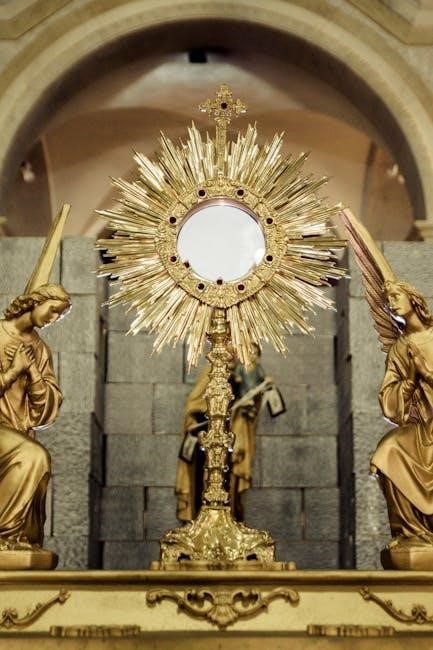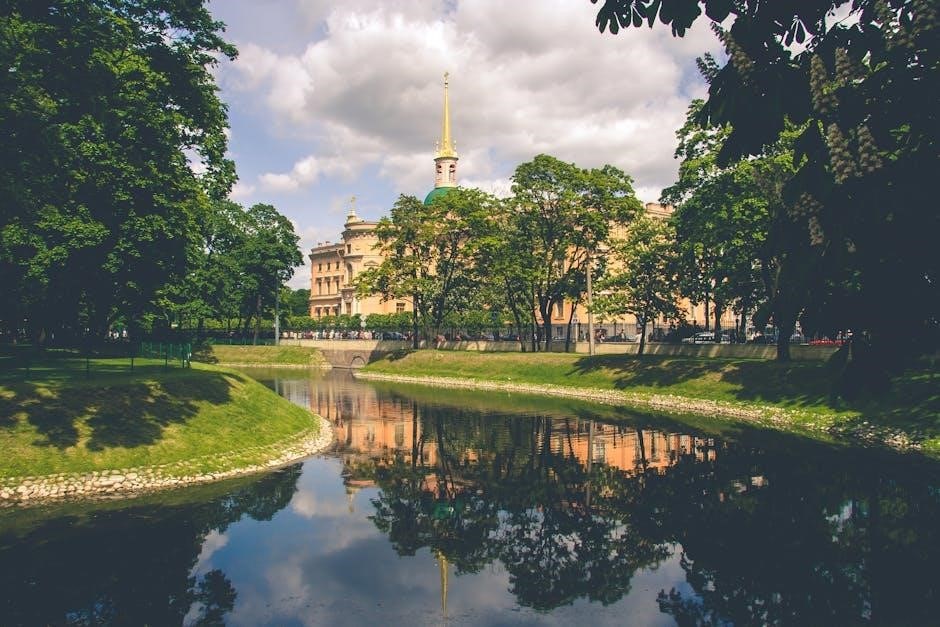
Guido Reni’s painting depicts Archangel Michael as a Roman deity, located in Santa Maria church, Rome, showcasing his artistic genius in the 17th century Italian art scene with remarkable oil on canvas works․
Historical Context of Guido Reni’s Painting
Guido Reni’s painting of Archangel Michael was created during the 17th century, a time of great artistic and cultural transformation in Italy․ The painting reflects the artistic styles and influences of the era, with Reni’s work being characterized by its use of light and color․ The historical context of the painting is also marked by the Counter-Reformation, a period of significant religious and artistic change․ Reni’s depiction of Archangel Michael, a symbol of Catholicism, reflects the artistic and religious values of the time․ The painting’s location in the church of Santa Maria della Concezione in Rome also provides insight into the historical context, as it was a prominent location for artistic and religious expression․ The painting’s creation in 1636, during the height of the Baroque period, further solidifies its historical significance, showcasing Reni’s mastery of the style and his contribution to the artistic landscape of 17th century Italy․

The Painting: Archangel Michael Tramples Satan
Guido Reni’s masterpiece depicts Archangel Michael triumphantly trampling Satan, showcasing dramatic movement and emotion with oil on canvas, a true Baroque masterpiece of religious art and symbolism always․
Commission and Completion of the Painting
The painting of Archangel Michael was commissioned in 1630, a significant period in Guido Reni’s career, and completed in 1636, showcasing his ability to work on projects over several years․
The commissioning of the painting is a testament to Guido Reni’s reputation as a leading artist of his time, with his works being sought after by churches and wealthy patrons․
The completion of the painting in 1636 marks a significant milestone in Guido Reni’s career, as it showcases his mastery of the Baroque style and his ability to create complex and emotionally charged works of art․
The painting’s completion also highlights Guido Reni’s attention to detail and his commitment to creating works of art that are both beautiful and meaningful, with the painting remaining one of his most famous works to this day, admired for its beauty and historical significance;

Guido Reni’s Style and Technique
Guido Reni’s style features fluidity and emotion, characterized by Baroque elements and oil on canvas techniques, creating powerful works of art with remarkable detail and expression always present․
Location and Significance of the Painting
The painting is located in the church of Santa Maria of the Conception in Rome, at the beginning of the famous Via Veneto, which adds to its historical and cultural significance․
The church itself is a notable landmark in Rome, and the painting is one of its most prized possessions․
The location of the painting in this church has played a significant role in its preservation and appreciation over the years․
The painting’s significance extends beyond its artistic value, as it is also an important part of the church’s history and heritage․
The church’s association with the painting has contributed to its reputation as a cultural and artistic hub in Rome․
The painting’s presence in the church has also influenced the development of art and architecture in the surrounding area․
Overall, the location and significance of the painting are deeply intertwined, and both have contributed to its enduring importance in the art world․

Guido Reni’s Life and Career
Guido Reni was a renowned Italian painter from Bologna, specializing in works of art with fluidity and emotion, creating a notable body of paintings throughout his career as a skilled artist․
Interpretation of the Painting
The painting of Archangel Michael by Guido Reni is a representation of the angel’s victory over Satan, symbolizing protection and triumph over evil․ According to Roman Catholic interpretations, Archangel Michael protects the Church, while in Jewish tradition, he safeguards the children of Israel․ The painting’s depiction of the devilish villain with the face of Cardinal Pamphilj, later Pope Innocent X, adds a layer of complexity to the artwork, suggesting a commentary on the politics and power struggles of the time․ The use of a Roman deity-like figure for Archangel Michael also implies a connection to classical mythology and the cultural heritage of Italy․ Overall, the painting offers a rich and multifaceted interpretation, inviting viewers to reflect on the themes of good, evil, and spiritual protection․ The artwork’s emotional and symbolic depth continues to inspire and fascinate audiences to this day, solidifying its place in the history of art․

Legacy of Guido Reni’s Painting
Guido Reni’s painting of Archangel Michael has left a lasting impact on the art world, influencing generations of artists and art enthusiasts․ The painting’s masterful use of composition, color, and light has made it a iconic representation of the Baroque style․ As a result, it has been widely studied and admired, with many considering it one of the greatest works of the 17th century․ The painting’s legacy extends beyond the art world, with Archangel Michael becoming a cultural symbol of protection and strength․ The image has been reproduced and reinterpreted in various forms of media, from sculptures to literature, cementing its place in popular culture․ Today, Guido Reni’s painting of Archangel Michael remains a beloved and enduring work of art, continuing to inspire and captivate audiences around the world with its beauty, emotion, and spiritual significance, ensuring its legacy will endure for generations to come, a true masterpiece of Renaissance art․